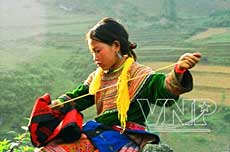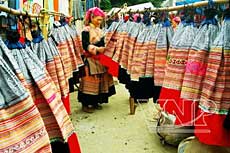The Mong ethnic people of Vietnam live mainly in the northern mountainous areas. To Mong women, the linen skirt plays a sacred role in their life.

Mong people belong to six branches including the Mong Do (white Mong), Mong Lenh (yellow Mong), Mong Sy (red Mong), Mong Sua (flower Mong), Mong Du (black Mong) and Mong Xanh (green Mong).
A local story says that when a Mong girl gets married, she often brings along with her a white linen dress sewn by her mother. Mong people have a saying: "Never eat the rice seeds, although starving, and wear a linen dress at death, although so poor when alive." A linen dress is not only casual wear, but a sign indicating the wearer's origin.
Growing and weaving flax, making linen clothes, embroidering or using wax to paint designs, all have long been traditional crafts of the Mong women.
Each Mong girl has a plot of land to grow flax from which she gets the threads to weave fabric and makes clothes for her parents, brothers and sisters and especially to fashion her own dress on her wedding day.
The designs embroidered or painted on the dress, preserved through the memories of Mong women, are diverse. They are nature-related patterns, such as a snail, a crab, a snake, a worm, a bird, or the flowers of such plants as pumpkin, garlic, or canarium.
Beside patterns in straight lines, Mong women are very skilful in embroidering circles, twisting and spiralling lines which are placed symmetrically, producing a flexible and harmonious composition.

These designs reflect the changes of the sun, weather, space and time, in the ancient view about the space of many populations, and are a common cultural treasure of many nationalities.
Mong women have two methods of embroidering, making regular and diagonal stitches which create supple, yet bold lines. This is quite different from the technique of slipping colourful threads through the horizontal or vertical fibre of the fabrics as practised by other ethnic groups.
A Mong woman's linen skirt is closed with many creases, large enough so that when unfolded and laid out, it will be a circle.
Women of each Mong ethnic group are differentiated by their skirt and the colours they use in their clothing. When wearing a skirt, they often put on a waist band made of embroidered fabric. Over their skirts these ladies wear an indigo coloured apron adorned with embroidered designs.
With only the four colours of green, red, white and yellow and embroidering by hand, Mong women can produce colourful and charming patterns on their dress, which reflect the rich and diverse natural environment.
Unique and beautiful, their dress is also something very special, not only because of the way it is made, but also it reflects the wearer's deep and intimate feelings.